I was in Lexington Thursday-Saturday to give the first of this year’s Committee on Social Theory lectures at the University of Kentucky. The theme this year is “Mapping“, and this was the first outing for “Gabriel’s Map: cartography and corpography in modern war”. The video will be posted online in a week or so, and there will also be an online interview with the journal disClosure, which is moving to a digital platform. I was last in Kentucky soon after I moved to UBC, so some time around 1989/90, to give one of the first of these lectures, and this occasion was as enjoyable as the first: many thanks to Jeremy Crampton and his wonderful colleagues and graduate students for such warm hospitality on such a chilly week! That said, being invited to talk about “Mapping” by Jeremy is like being invited to talk about Marxism by David Harvey, so I was relieved everything went so well; I learned much from the questions, comments and conversations, so no doubt the second outing will see a different presentation. Then, somewhere down the line, I’ll translate it into written form.
One of the most enjoyable parts of preparing a presentation, for me anyway, is the image research and design, which invariably takes me to sites and sources I’d never otherwise find. And because it can take an age to find the right image, it slows down the process and gives me time to think more carefully (and I hope creatively) about the argument I’m developing. This was no exception: again and again, as I raided image banks on the First World War, I encountered the work of Australian photographer and film-maker Frank Hurley (1885-1962). In fact, it’s one of his photographs that I cut for the banner of this blog (‘Moving Forward/Supporting troops of the 1st Australian Division walking on a duckboard track near Hooge, in the Ypres Sector’).
 When the First World War began Hurley was in Antarctica as the photographer for the Imperial Trans-Antarctic Expedition, Ernest Shackleton‘s legendary attempt to reach the South Pole on foot in 1914-1917, which ended in near disaster when the expedition’s support vessel became trapped and was eventually crushed in the pack ice. The First Officer on the ill-fated Endurance described Hurley as ‘a warrior with his camera’ who would ‘go anywhere or do anything to get a picture.’
When the First World War began Hurley was in Antarctica as the photographer for the Imperial Trans-Antarctic Expedition, Ernest Shackleton‘s legendary attempt to reach the South Pole on foot in 1914-1917, which ended in near disaster when the expedition’s support vessel became trapped and was eventually crushed in the pack ice. The First Officer on the ill-fated Endurance described Hurley as ‘a warrior with his camera’ who would ‘go anywhere or do anything to get a picture.’
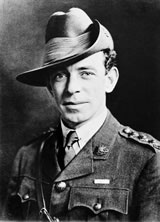 Sure enough, soon after he returned to England Hurley was appointed as one of two official photographers to the Australian Imperial Force (AIF) in July 1917 with the honorary rank of Captain. (War correspondents were expressly forbidden to take photographs, which is why official photographers were appointed – and subject to regulation and censorship). Hurley left England the following month for what he called ‘the grim duties of France’. He was constantly haunted by the horror gouged into the landscape of the front line:
Sure enough, soon after he returned to England Hurley was appointed as one of two official photographers to the Australian Imperial Force (AIF) in July 1917 with the honorary rank of Captain. (War correspondents were expressly forbidden to take photographs, which is why official photographers were appointed – and subject to regulation and censorship). Hurley left England the following month for what he called ‘the grim duties of France’. He was constantly haunted by the horror gouged into the landscape of the front line:
‘After, we climbed to the crest of hill 60, where we had an awesome view over the battlefield to the German lines. What an awful scene of desolation! Everything has been swept away: only stumps of trees stick up here & there & the whole field has the appearance of having been recently ploughed. Hill 60 long delayed our infantry advance, owing to its commanding position & the almost impregnable concrete emplacements & shelters constructed by the Bosch. We eventually won it by tunnelling underground, & then exploding three enormous mines, which practically blew the whole hill away & killed all the enemy on it. It’s the most awful & appalling sight I have ever seen. The exaggerated machinations of hell are here typified. Everywhere the ground is littered with bits of guns, bayonets, shells & men. Way down in one of these mine craters was an awful sight. There lay three hideous, almost skeleton decomposed fragments of corpses of German gunners. Oh the frightfulness of it all… Looking across this vast extent of desolation & horror, it appeared as though some mighty cataclysm had swept it off & blighted the vegetation, then peppered it with millions of lightning stabs. It might be the end of the world where two irresistible forces are slowly wearing each other away.’
Or again:
‘The Menin Rd is one of the, if not the, most ghastly approach on the whole front. Accretions of broken limbers, materials & munitions lay in piles on either side, giving the road the appearance of running through a cutting. Any time of the day it may be shelled & it is absolutely impossible owing to the congested traffic for the Boche to avoid getting a coup with each shell. The Menin road is like passing through the Valley of death, for one never knows when a shell will lob in front of him. It is the most gruesome shambles I have ever seen…’
But throughout his diary he is also evidently entranced, even thrilled by the aesthetic effect of such spectacular violence:
‘The battlefield in the night was a wonderful sight of star shells & flashes. The whole sky seemed a crescent of shimmering sheet lightning like illumination. It was all very beautiful yet awesome and terrible.’
 At Ypres, he confesses that the shattered town is now ‘aesthetically … far more interesting than the Ypres that was’. Making his way along the Menin Road at twilight:
At Ypres, he confesses that the shattered town is now ‘aesthetically … far more interesting than the Ypres that was’. Making his way along the Menin Road at twilight:
‘No sight could be more impressive than walking along this infamous shell swept road, to the chorus of the deep bass booming of the drum fire, & the screaming shriek of thousands of shells. It was great, stupendous & awesome.’
Later:
‘The shells shrieked in an ecstasy overhead, & the deep boom of artillery sounded like a triumphant drum roll. Those murderous weapons the machine guns maintained their endless clatter, as if a million hands were encoring & applauding the brilliant victory of our countrymen. It was ineffably grand & terrible…’
Above all, Hurley was tormented by the difficulty of conveying the full extent of what he saw in a single exposure. In his diary he confided that
‘We have even a worse time than the infantry, for to get pictures one must go into the hottest & even then come out disappointed. To get War pictures of striking interest & sensation is like attempting the impossible.’
He later explained:
‘None but those who have endeavoured can realise the insurmountable difficulties of portraying a modern battle by the camera. To include the event on a single negative, I have tried and tried, but the results are hopeless. Everything is on such a vast scale. Figures are scattered — the atmosphere is dense with haze and smoke — shells will not burst where required — yet the whole elements of a picture are there could they but be brought together and condensed.’
Hurley passionately believed that it was only by the superimposition of different negatives to form a single, ‘condensed’ image that he could re-present the violence of war – and, I think, its shocking, thrilling aesthetic. Towards the end of September 1917 Hurley recorded
‘a great argument with Bean about combination pictures. Am thoroughly convinced that it is impossible to secure effects – without resorting to composite pictures.’
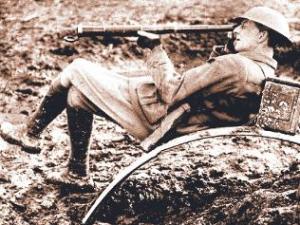 Charles Bean was Australia’s Official War Correspondent (more here, and for the documentary-drama, Charles Bean’s Great War, see here), and he was equally adamant that Hurley’s method was itself so violent that it destroyed the truth: to Bean, Hurley’s montages were ‘little short of fake’ and violated the imperative to view photographs as ‘sacred records’ of the war. Indeed, Bean insisted that ‘press photography in this war is such a construction of flimsy fake,’ and ‘that is the last thing a historian wants to build on.’ In October Bean presented an ultimatum to which Hurley responded in a characteristically uncompromising fashion:
Charles Bean was Australia’s Official War Correspondent (more here, and for the documentary-drama, Charles Bean’s Great War, see here), and he was equally adamant that Hurley’s method was itself so violent that it destroyed the truth: to Bean, Hurley’s montages were ‘little short of fake’ and violated the imperative to view photographs as ‘sacred records’ of the war. Indeed, Bean insisted that ‘press photography in this war is such a construction of flimsy fake,’ and ‘that is the last thing a historian wants to build on.’ In October Bean presented an ultimatum to which Hurley responded in a characteristically uncompromising fashion:
‘Had a lengthy discussion with Bean re pictures for Exhibition & publicity purposes. Our Authorities here will not permit me to pose any pictures or indulge in any original means to secure them. They will not allow composite printing of any description, even though such be accurately titled nor will they permit clouds to be inserted in a picture. As this absolutely takes all possibilities of producing pictures from me, I have decided to tender my resignation at once. I conscientiously consider it but right to illustrate to the public the things our fellows do & how war is conducted. These can only be got by printing a result from a number of negatives or reenactment. This is out of reason & they prefer to let all these interesting episodes pass. This is unfair to our boys & I conscientiously could not undertake to continue the work.’
The next morning Hurley resigned:
‘I sent in my resignation this morning & await the result of igniting the fuse. It is disheartening, after striving to secure the impossible & running all hazards to meet with little encouragement. I am unwilling & will not make a display of war pictures unless the military people see their way clear to give me a free hand. Canada has made a great advertisement out of their pictures & I must beat them.’
According to Robert Dixon’s engaging essay ‘Travelling Mass-Media Circus: Frank Hurley and Colonial Modernity’, Hurley had Canada in his sights because the Canadian War Records Office had staged a highly successful photographic exhibition at the Grafton Galleries in London the previous December, which had included vast enlargements using multiple negatives; the follow-up exhibition in July had as its centrepiece what was advertised as ‘the largest photograph in the world’, ‘Dreadnoughts of the Battlefield’, which occupied an entire wall of the gallery.
Within days a compromise of sorts had been reached: Hurley was allowed to make six ‘combination enlargements’ for his public exhibition, provided they were clearly labelled as composites, and he withdrew his resignation. (For more on the spat between Hurley and Bean, and the vexed political-epistemological issues at stake, see here).
But it was not until May 1918 – after he had completed a photographic expedition to record Australian troops fighting in Palestine – that Hurley was able to prepare his photographs for the London exhibition (the catalogue for the later show in Sydney is here). He was particularly excited by two montages. The first, ‘DEATH THE REAPER” was made up of two negatives: ‘One, the foreground, shows the mud-splashed corpse of a Boche floating in a shell crater. The second is an extraordinary shell burst: the form of which resembles death.’
What is striking about Hurley’s gloss – and the composition of the image itself – is the evident striving for a particular aesthetic effect: the compulsion to ‘secure effects’ (above) that were also affects. Hurley reserved his most extravagant self-praise for a second photo-work which was made from 12 separate negatives:
‘Our largest picture, “THE RAID”, depicting an episode an the Battle of Zonneke [south-west of Passchendaele] measures over 20 ft. x 15’6″ high. Two waves of infantry are leaving the trenches in the thick of a Boche Barrage of shells and shrapnel. A flight of Bombing Aeroplanes accompanies them. An enemy plane is burning in the background. The whole picture is realistic of battle, the atmospheric effects of battle smoke are particularly fine.’
You can see an animation of the composition process here and a video here, and although Hurley claims this as a ‘realistic’ photo-work, the process of composition is, again, an artfully studied one that was plainly intended to produce a particular aesthetic – and cinematic – effect.
Even more than this, though, Hurley was – as Julian Thomas makes very clear here, a show man: Robert Dixon argues that by the 1920s ‘Hurley had become not only the ring-master but also the main attraction in his own travelling, international, multi- and mass-media circus.’ (Given how much I enjoy devising my own presentations, perhaps that’s also why I find the man so interesting….).
And ‘The Raid’, sometimes also called ‘Over the top’ (shown leaning against a wall in London, left) was his bid to produce ‘the largest picture in the world’ (a quest which shows no sign of coming to an end).
You can find online galleries of Hurley’s photographs from the First World War here. I used several of them in my presentation at Lexington, and so this excursion into Hurley’s war work is not a side-track: I also used passages from several novels (clearly noted as such), partly to trouble the simple distinctions between ‘fiction’ and ‘non-fiction’ and to draw attention to the constructedness of our histories, but partly too because there are some truths (sic) that can be conveyed most effectively through the imaginative resources of the novel. In the case of Tom McCarthy’s luminous novel C, which I’ve invoked before, there are complex relationships between the documentary record and the fictional narrative: C is clearly a work of prodigious imagination, but just as clearly saturated in archival research. I’m left wondering what a latter-day Hurley would have made of it – and whether photographs are still subject to more stringent protocols than texts as a result of a presumptive indexicality. What now counts as ‘fakery’ once Bean’s ‘sacred records’ have become secularised?

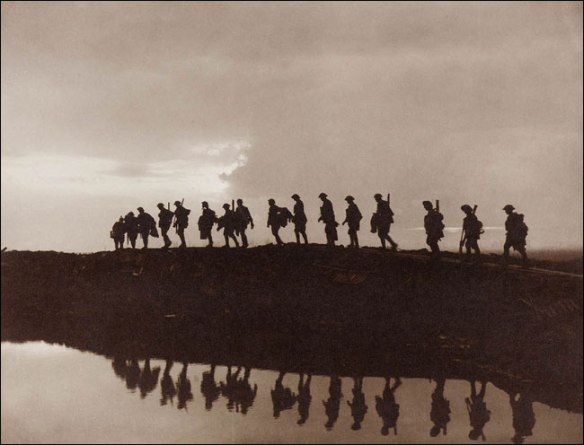

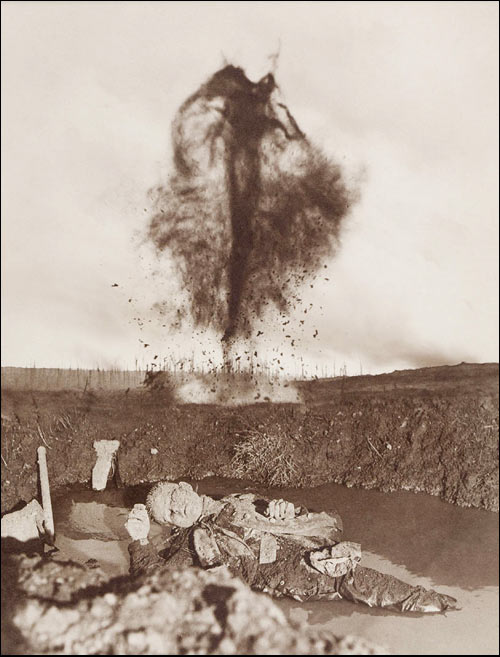
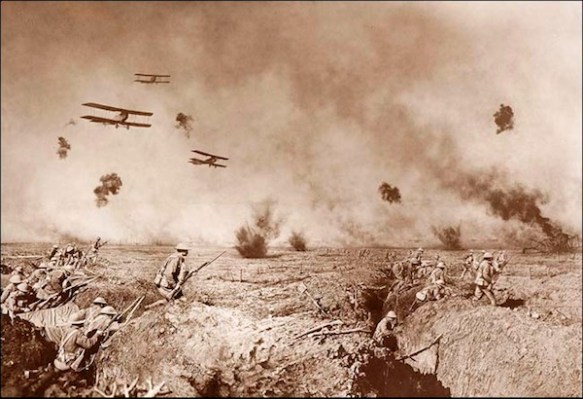
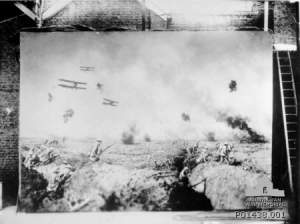
Pingback: The Leaden Hours | geographical imaginations
Pingback: Headings | geographical imaginations
Pingback: 3-D War « geographical imaginations
Pingback: ‘A foreign field that is forever England’? « geographical imaginations